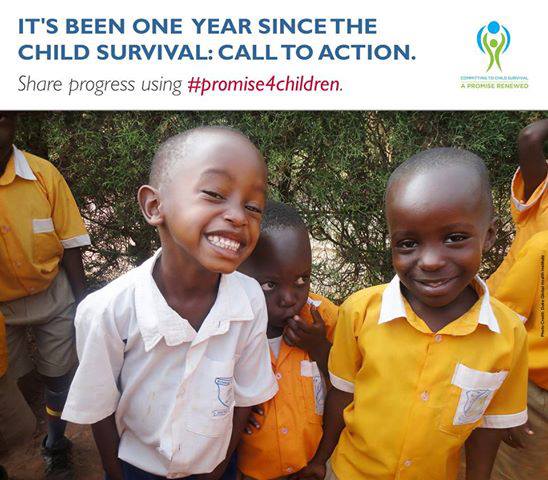Making a Fifth Birthday Within Reach
|

Reposted from USAID's Impact Blog
It's been a year since the United States joined UNICEF and the governments of Ethiopia and India in a bold pledge to end preventable child deaths within a generation. Last week marked the first anniversary of the Child Survival Call to Action, which has since spurred a rejuvenated global movement under the banner “Committing to Child Survival: A Promise Renewed.” In the past year, 174 governments pledged to redouble efforts for children. More than 200 civil-society organizations, 91 faith-based organizations, and 290 faith leaders from 52 countries signed their own pledges of support.
In the Rayburn House Office Building yesterday, members of Congress, PATH, the U.S. Agency for International Development's (USAID's) flagship Maternal and Child Health Integrated Program, the US Fund for UNICEF, and partner organizations celebrated the global commitment and the progress made so far. We also reminded ourselves of how critical it is to sustain this momentum because, to borrow the words of Anthony Lake, UNICEF's executive director, “The story of child survival over the past two decades is one of significant progress and unfinished business.”
Progress: dramatic drop in child deaths
The number of children under age five who die each year has dropped from nearly 12 million in 1990 to less than 7 million in 2011. Translated another way, every day 14,000 children who would have otherwise died now live to see their fifth birthdays.
Particularly heartening is the progress made in countries that have carried some of the heaviest burden of child mortality. Nine countries, from Bangladesh to Cambodia to Rwanda, reduced their under-five mortality rate by 60 percent or more.
How far these countries have come is a testament to the unwavering commitment and sustained efforts of governments, the public and private sector, donors and nonprofits, civil-society groups, and communities. Other factors underpinning this global progress are impressive gains made in the research and development of medical technologies, improved ways of delivering health services, and bold new thinking in how we overcome roadblocks and speed up innovation for health equity.
Unfinished business: 7 million children
Today, almost two-thirds of child deaths are caused by diseases and conditions that rarely take a child's life in wealthy countries, including diarrhea, malaria, tetanus, and measles. These deaths are also concentrated in a small number of countries—more than four-fifths occur in sub-Saharan Africa and South Asia. This health inequity is deepened by poverty, violence, political fragility, and social disparity.
As the tremendous progress to date has shown, these are not insurmountable factors—but overcoming them requires ongoing cross-sector collaboration, multi-intervention solutions, and investment in innovative approaches.
Innovating health technologies
I joined PATH as head of its Drug Development program just under a year ago because I saw how global health organizations are driving many of the transformative innovations needed to achieve big goals like the Child Survival Call to Action. For more than 30 years, PATH and our partners have advanced innovative health technologies to protect children from devastating illnesses, make childbirth safer, and provide families with tools for a healthy life. Tools like a vaccine against meningitis A developed specifically for Africa, which has been introduced in ten countries and protected more than 103 million people from epidemic meningitis. Or tools like vaccines for rotavirus and pneumonia, which have been introduced in 14 GAVI-eligible countries, or a feeding technology that ensures that premature babies and those with a cleft palate can access lifesaving breast milk.
On the first anniversary of the Call to Action, I feel even more convinced of the importance of research and development of innovative health technologies to fight against the leading causes of child death. This is why at PATH we are currently working on solutions to tackle the top child killers, like diarrhea, on many fronts. We are developing new drugs to shorten the severity and duration of diarrhea before it becomes fatal, while also working to improve the effectiveness of proven diarrhea therapies like oral rehydration solution. PATH is also working on new vaccines against the leading causes of diarrheal disease, helping countries increase access to existing vaccines for both rotavirus and pneumonia, developing and delivering safe water treatment and storage products, and advancing health devices, such as a user-friendly product design for amoxicillin dispersible tablets to treat pneumonia.
The road ahead
Yesterday's briefing is a reminder of the critical value of sustained commitment to our children. It is an opportunity to emphasize the power of innovation for child health and get inspired by the momentum behind the current efforts to create effective health solutions.
Among other factors, development of innovative health technologies and new methods to deliver these solutions to the people who need them will continue to drive the current momentum forward toward our common goal of ending preventable child and maternal deaths. Because access to necessary vaccines, drugs, basic medical and maternal care, clean water, and adequate nutrition should not be marked by a line of health inequity.
June 14 marked the 1 year anniversary of the Child Survival: Call to Action. One year ago, leaders committed to ending preventable child deaths. Learn more about A Promise Renewed.














